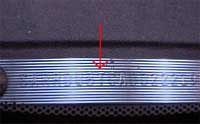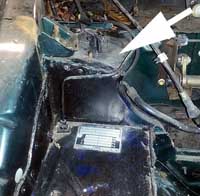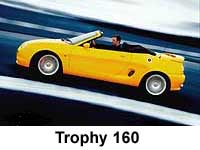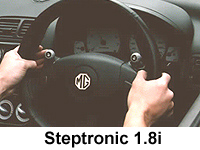
|
Words: Rob Bell; |
| Contents |
Introduction | Where is the chassis number | The Chassis code | Conclusions |
|
|
How to interpret Chassis
codes on the MGF/TF
|
What is a chassis number, or Vehicle Identifier Number (VIN)? Who cares? Well, the licencing authorities certainly do – and as we all know the VIN is unique to any particular car and it makes it harder for the criminally minded to steal a car and pass it off under another identity. Other than the security function, the licencing authorities can find out what homologation rules apply to your car, and how much road tax to charge you each year. But what is interesting for the enthusiast or the car buyer is what other snippets of information are encoded in that alphabetti-spaghetti cypher that is the modern chassis number.
Where is the Chassis number?
 |
 |
 |
Pictured from above, anti-clockwise: at the base of the windscreen on the left hand side (attached to the dashboard); bright metal chassis plate on left side of spare wheel (behind ABS, if fitted); on suspension turret behind and chassis plate (arrowed). Beware a car with an altered identity: in this image, the identity of another car has been crudely added to another car - note untidy welding, black paint, with underlying blue showing through... |
Firstly, where do you find the VIN? It’s actually in three places on the MG. One is at the base of the windscreen in the left hand bottom corner. Another is on the VIN plate, pop-riveted under the bonnet to the left of the spare wheel as you look in (behind the ABS pump, if the car you are looking at is fitted with one). The last one is actually stamped on a body panel – near the front damper upper mount on the left (for the right hand front wheel). This last one is intended to be tamper-proof – as the others can readily be removed or replaced.
You now know where you can find the VIN numbers, but what on earth does it all mean?
Let’s take a hypothetical VIN number: SARRDWBGBAD123456.
Firstly, it is obviously fictitious because the number is far too high for what is other wise an early MGF chassis number. The car is a right hand drive manual 1.8 MPi model and would have been manufactured sometime between 1995 and 1997.
What follows is how we can identify such a car just from the VIN plate...
| The Unique Identifier Code: SARRDWBGBAD123456 |
Let’s start with the easy bit first: the 6-digit number at the end of the VIN. This is the unique identifier for your vehicle. The lower the number, the earlier it was off the production line – although if you own the MGF with the VIN 000751, it doesn’t mean you own the 751st car off the line. Like all MGs, the chassis numbers for production cars start at 000251 – the old Abingdon works telephone number. So does that mean you’ve actually got the 500th car off the production line? Er, no. It might be, but chances are more likely to be not thanks to the way that the assembly line worked; cars rarely went through in true numerical order… so it might be earlier or later than the number suggests. But it would certainly be an early 1995-build car!
Vehicles with VINs of less than 000251 are actually pre-production
vehicles. In the normal run of things, these cars would have been decommissioned
and crushed. However, these cars lived a charmed life: many were were used on
the Rover Press Fleet, driven by journalists and then were sold on to loyal MG
club members wanting to participate in motor sport. Many were converted for this
intended purpose, but rather a lot were kept on for road duty – and they do crop
up for sale from time to time.
| The Manufacturer/ Country of Manufacture/ Model Code : SARRDWBGBAD123456 |
Moving to the letters now, and the first 5-letter grouping: "SARRD". This is the same on all MGFs and TFs manufactured before the collapse of MG Rover in 2005. It carries the information on where a car is built, the manufacturer, the Marque and the model. The later Chinese cars carry a different code here: "SDPRD". The D is the code for the PR3/ MGF/ MG TF.
| Body/Trim Code : SARRDWBGBAD123456 |
 The Trophy 160 has a unique chassis number - "Z" in the body/trim code, and a "P" in the engine code positions - making genuine cars relatively easy to identify. |
The next letter, "W" in our example, tells us about the body/trim level. W is the commonest trim specified, but there are others too. Sadly, MG Rover decided not to identify special editions using a unique letter – which is a shame, but interestingly, if the engine was anything other than a 1.8 litre MPi (118bhp/120PS or 135 – be that K or N-series) or 145PS VVC, it had a different letter.
The letter "M" signifies a 1.6 litre engine for example.
160PS VVC-equipped cars got the letter "Z" if it was an MGF Trophy or the letter "L" if it was a TF160.
Therefore, although a body/trim level identifier, on the MGF/TF it actually
tells us more about the engine originally fitted!!!
| Body Style Code : SARRDWBGBAD123456 |
The letter "B" is always the same on the MGF/TF irrespective of model: it signifies a 2-seat convertible body style. Any future MG roadster will have the same 7th letter!
| Engine Code : SARRDWBGBAD123456 |
 160PS VVC engines are identifiable from the letter "P" in the 8th character position. |
Next is the letter "G". The 8th letter is invaluable for identifying the engine originally fitted to the car. "G" is the 1.8 16 valve K-series engine in 120PS (118 bhp) tune. When this engine is upgraded to the 135PS state of tune, the letter changed to "K". "T" denotes a 145PS VVC, which when in the 160PS tune, changes to the letter "P". The 1.6-litre 16-valve K-series gets the letter "E". If you see a car with the letter "N", then chances are you are in South America, looking at a Mexican-spec VVC 150!
| Configuration Code : SARRDWBGBAD123456 |
 Steptronic cars are identifiable by the letter "J" |
The 9th letter, "B" in our example, tells us that this car is a right-hand drive manual (left hand drive manuals get the letter "M").
But there isn’t just one manual transmission option on these MGs: MPi-engined cars (1.6 and 1.8s in 120PS guise) get a different differential (final drive) ratio to the VVC – and so this is depicted by a different letter, the VVC getting the letter "C" – or "X" if left hand-drive.
This final drive ratio was shared between the TF135 and TF160, and therefore both models use the same letter "C" or "X" depending on which side the steering wheel is located.
If you had a Steptronic CVT-automatic on your car, the letter code,
predictably, was different: "J" on right-hand drive cars, and "X"
on left-hand drive cars.
| Generation/ model year Code : SARRDWBGBAD123456 |
| Year | Code |
| 1995-1997 | A |
| 1998 | W |
| 1999 | X |
| 2000 | Y |
| 2001 | 1 |
| 2002 | 2 |
| 2003 | 3 |
| 2004 | 4 |
| 2005 | 5 |
| 2008 | 8 |
| 2009 | 9 |
The penultimate letter in our example is the letter "A". This letter changed according to significant model updates – and it is interesting to see that after around 1998, there was a new model number every year. However, between launch in 1995 to around 1997, only one letter here – the letter "A".
"W" corresponds to around 1998, "X" 1998/1999 and "Y" 1999/2000. Thereafter this letter changed to a number, likely corresponding to its model year – i.e. a 2001 model year got the number "1" which increments to the 2005 model year, with number "5".
Interestingly, for the
Chinese-era cars, the model year number continued from 2008 to 2009
with numbers "8" or "9" – so there is a way of estimating what
year your car was built independently of the date on which it was registered
(which you will find recorded on your V5C document).
| Factory Code : SARRDWBGBAD123456 |
The final letter, "D", is the same for all MGFs and TFs – and tells you which assembly plant was used to build your car. All UK-sold cars were assembled at Longbridge – letter "D". Sadly, I am not aware of the letter assigned to the NAC assembly plant in China – anyone know?
Therefore the VIN contains a veritable treasure trove of information. It may actually be of more use to the car buyer than to the current owner – but it is interesting to look at nonetheless. And cross reference it to your engine number: has someone undertaken a sneaky engine transplant without registering the change for example?